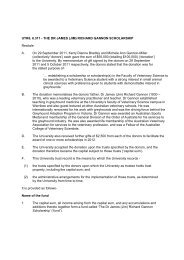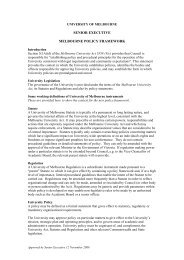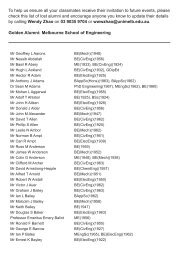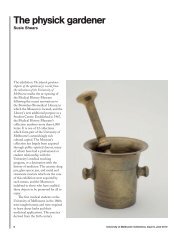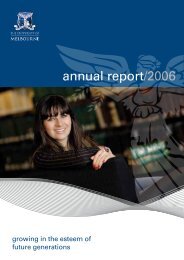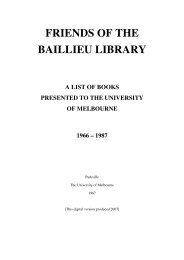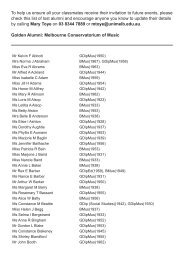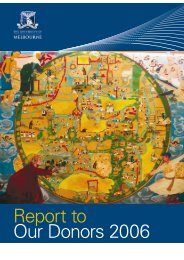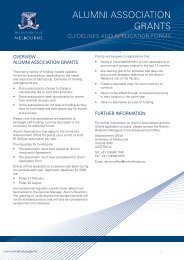2007 Annual report (PDF 8.1 Mb) - University of Melbourne
2007 Annual report (PDF 8.1 Mb) - University of Melbourne
2007 Annual report (PDF 8.1 Mb) - University of Melbourne
Create successful ePaper yourself
Turn your PDF publications into a flip-book with our unique Google optimized e-Paper software.
NOTES TO AND FORMING PART OF THE<br />
FINANCIAL STATEMENTS FOR THE YEAR ENDED 31 DECEMBER <strong>2007</strong><br />
NOTE 1: STATEMENT OF SIGNIFICANT ACCOUNTING POLICIES (CONTINUED)<br />
1.5 Income Tax<br />
The <strong>University</strong> <strong>of</strong> <strong>Melbourne</strong> and its subsidiaries, with the exception <strong>of</strong> some <strong>of</strong> the wholly owned subsidiaries <strong>of</strong> UMEE Ltd, are exempt<br />
from income tax pursuant to Part 50.1 <strong>of</strong> the Income Tax Assessment Act 1997. The overseas subsidiaries <strong>of</strong> UMEE Ltd are subject to<br />
income tax in the relevant tax jurisdictions.<br />
The balance sheet method <strong>of</strong> tax-effect accounting is adopted.<br />
1.6 Cash and Cash Equivalents<br />
For the purpose <strong>of</strong> the Cash Flow Statement, cash and cash equivalents include cash on hand and at bank, at-call deposits and bank bills<br />
with a maturity <strong>of</strong> 90 days or less.<br />
1.7 Trade Receivables<br />
Trade receivables are recognised initially at fair value and subsequently measured at amortised cost less any provision for impairment.<br />
Trade receivables are due for settlement no more than 30 days from the date <strong>of</strong> recognition.<br />
Collectibility <strong>of</strong> trade receivables is reviewed on an ongoing basis. Debts which are known to be uncollectible are written <strong>of</strong>f. A provision<br />
for impairment <strong>of</strong> receivables is established when there is objective evidence that the Group will not be able to collect all amounts due<br />
according to the original terms <strong>of</strong> receivables. Significant financial difficulties <strong>of</strong> the debtor, probability that the debtor will enter bankruptcy<br />
or financial reorganisation, and default or delinquency in payments (more than 30 days overdue) are considered indicators that the trade<br />
receivable is impaired. The amount <strong>of</strong> the provision is the difference between the asset’s carrying amount and the present value <strong>of</strong><br />
estimated future cash flows. Cash flows relating to short-term receivables are not discounted as the effect <strong>of</strong> discounting is immaterial.<br />
The amount <strong>of</strong> the provision is recognised in the Income Statement.<br />
The carrying amount <strong>of</strong> the asset is reduced through the use <strong>of</strong> an allowance account and the amount <strong>of</strong> the loss is recognised in the<br />
Income Statement in Note 13. When a trade receivable is uncollectible, it is written <strong>of</strong>f against the allowance account for trade receivables.<br />
Subsequent recoveries <strong>of</strong> amounts previously written <strong>of</strong>f are credited against other expenses in the Income Statement.<br />
1.8 Inventories<br />
<strong>Annual</strong> stocktakes <strong>of</strong> inventories are undertaken at all locations.<br />
Inventories comprising Finished Goods, Raw materials, Work in progress, Fodder and Hay stocks are measured at the lower <strong>of</strong> cost and net<br />
realisable value, with adjustments made to take account <strong>of</strong> obsolescence.<br />
The Group’s livestock, orchards and picked fruit are measured at their fair value less estimated point-<strong>of</strong>-sale costs in accordance with AASB<br />
141 Agriculture. The fair value <strong>of</strong> these items is determined based on market prices in the local area.<br />
Costs are assigned to individual items <strong>of</strong> inventory on the basis <strong>of</strong> the first-in, first-out method.<br />
1.9 Financial Instruments<br />
AASB 139 Financial Instruments: Recognition and Measurement has four categories <strong>of</strong> financial instruments including: financial assets<br />
at fair value through pr<strong>of</strong>it or loss, loans and receivables, held-to-maturity investments, and available-for-sale financial assets. The<br />
classification <strong>of</strong> investments depends on the purpose for which they were acquired. The classification <strong>of</strong> investments is determined by<br />
management at initial recognition and is re-evaluated at each <strong>report</strong>ing date.<br />
(i) Financial Assets at Fair Value through Pr<strong>of</strong>it or Loss<br />
This category has two sub-categories: financial assets held for trading, and those designated at fair value through pr<strong>of</strong>it or loss on<br />
initial recognition. A financial asset is classified in this category if acquired principally for the purpose <strong>of</strong> selling in the short term or if<br />
so designated by management. Derivatives are categorised as held for trading unless they are designated as hedges. Assets in this<br />
category are classified as current assets if they are either held for trading or are expected to be realised within twelve months <strong>of</strong> the<br />
balance sheet date. Realised and unrealised gains and losses are included in the Income Statement in the period in which they arise.<br />
(ii)<br />
(iii)<br />
(iv)<br />
Commercial paper, floating rate notes and corporate securities were designated at the date <strong>of</strong> transition to AIFRS as financial assets<br />
at fair value through pr<strong>of</strong>it or loss. Realised and unrealised gains and losses arising from changes in the fair value <strong>of</strong> the ‘financial<br />
assets at fair value through pr<strong>of</strong>it or loss’ category are included in the Income Statement in the period in which they arise.<br />
Loans and Receivables<br />
Loans and receivables are non derivative financial assets with fixed or determinable payments that are not quoted in an active market.<br />
They arise when an entity provides money, goods or services directly to a debtor with no intention <strong>of</strong> selling the receivable. They<br />
are included in current assets, except for those with maturities greater than twelve months after the balance sheet date, which are<br />
classified as non-current assets. Loans and receivables are carried at amortised cost using the effective interest method.<br />
Held-to-Maturity Investments<br />
Held-to-maturity investments are non-derivative financial assets with fixed or determinable payments and fixed maturities where<br />
management has the positive intention and ability to hold to maturity. Held‐to‐maturity investments are carried at amortised cost<br />
using the effective interest method. At the <strong>report</strong>ing date, the Group did not hold any financial assets in this category (2006, Nil).<br />
Available-for-Sale Financial Assets<br />
Available-for-sale financial assets, comprising principally marketable equity securities, are non-derivatives that are either designated<br />
in this category or not classified in any <strong>of</strong> the other categories. They are included in non‐current assets unless management intends<br />
to dispose <strong>of</strong> the investment within twelve months <strong>of</strong> the balance sheet date.<br />
Shares, convertible notes and listed income securities were designated at the date <strong>of</strong> transition to AIFRS as available‐for‐sale<br />
financial assets. Unrealised gains and losses arising from changes in the fair value are recognised in equity in the available-for-sale<br />
investments revaluation reserve. When securities classified as available‐for‐sale are sold or impaired, the accumulated fair value<br />
adjustments are included in the Income Statement as unrealised gains and losses from investment securities.






